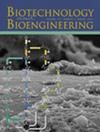Hybrid Modeling of the Reversed‐Phase Chromatographic Purification of an Oligonucleotide: Few‐Shot Learning From Differentiable Physics Solver‐in‐the‐Loop
IF 3.5
2区 生物学
Q2 BIOTECHNOLOGY & APPLIED MICROBIOLOGY
引用次数: 0
Abstract
Hybrid models integrate mechanistic and data‐driven components, effectively addressing the challenges of limited process understanding and data availability typical of biopharmaceutical processes. In this study, we applied a hybrid modeling framework named differentiable physics solver‐in‐the‐loop (DP‐SOL) to describe the reversed‐phase chromatographic purification of an oligonucleotide, overcoming the mentioned limitations of purely mechanistic and data‐driven models. The framework establishes a connection between neural networks (NNs) and mechanistic models through differentiable physical operators and their gradients. We first collected a data set comprising six linear gradient elution experiments at different resin loadings and gradient slopes, split in three experiments each for training and testing, for few‐shot learning. The hyperparameters were determined through a grid search, resulting in a NN with two hidden layers and 14 nodes. Compared to a calibrated mechanistic model used for initialization of NN, the DP‐SOL hybrid model showed significant performance improvement on both training and testing sets, with 0.97 for the former. The good predictivity of DP‐SOL is attributed to the combination of mechanistic models and NNs at the solver level. As a novel and versatile hybrid modeling paradigm, DP‐SOL has the potential to significantly impact modeling approaches in the downstream processing field and the broader biopharmaceutical sector.反相色谱纯化寡核苷酸的混合建模:从可微分物理求解器中学习
混合模型集成了机制和数据驱动组件,有效地解决了生物制药过程中典型的有限过程理解和数据可用性的挑战。在这项研究中,我们应用了一个名为可微分物理求解器-在-环(DP - SOL)的混合建模框架来描述寡核苷酸的反相色谱纯化,克服了上述纯机制和数据驱动模型的局限性。该框架通过可微物理算子及其梯度建立了神经网络与机制模型之间的联系。我们首先收集了一个数据集,包括六个不同树脂负载和坡度的线性梯度洗脱实验,分为三个实验,每个实验用于训练和测试,用于少量学习。通过网格搜索确定超参数,得到一个包含两个隐藏层和14个节点的神经网络。与用于神经网络初始化的校准机制模型相比,DP - SOL混合模型在训练集和测试集上的性能都有显著提高,前者的性能提高了0.97。DP‐SOL具有良好的预测能力,这要归功于机制模型和神经网络在求解器水平上的结合。DP - SOL作为一种新颖且通用的混合建模范式,有可能对下游加工领域和更广泛的生物制药领域的建模方法产生重大影响。
本文章由计算机程序翻译,如有差异,请以英文原文为准。
求助全文
约1分钟内获得全文
求助全文
来源期刊

Biotechnology and Bioengineering
工程技术-生物工程与应用微生物
CiteScore
7.90
自引率
5.30%
发文量
280
审稿时长
2.1 months
期刊介绍:
Biotechnology & Bioengineering publishes Perspectives, Articles, Reviews, Mini-Reviews, and Communications to the Editor that embrace all aspects of biotechnology. These include:
-Enzyme systems and their applications, including enzyme reactors, purification, and applied aspects of protein engineering
-Animal-cell biotechnology, including media development
-Applied aspects of cellular physiology, metabolism, and energetics
-Biocatalysis and applied enzymology, including enzyme reactors, protein engineering, and nanobiotechnology
-Biothermodynamics
-Biofuels, including biomass and renewable resource engineering
-Biomaterials, including delivery systems and materials for tissue engineering
-Bioprocess engineering, including kinetics and modeling of biological systems, transport phenomena in bioreactors, bioreactor design, monitoring, and control
-Biosensors and instrumentation
-Computational and systems biology, including bioinformatics and genomic/proteomic studies
-Environmental biotechnology, including biofilms, algal systems, and bioremediation
-Metabolic and cellular engineering
-Plant-cell biotechnology
-Spectroscopic and other analytical techniques for biotechnological applications
-Synthetic biology
-Tissue engineering, stem-cell bioengineering, regenerative medicine, gene therapy and delivery systems
The editors will consider papers for publication based on novelty, their immediate or future impact on biotechnological processes, and their contribution to the advancement of biochemical engineering science. Submission of papers dealing with routine aspects of bioprocessing, description of established equipment, and routine applications of established methodologies (e.g., control strategies, modeling, experimental methods) is discouraged. Theoretical papers will be judged based on the novelty of the approach and their potential impact, or on their novel capability to predict and elucidate experimental observations.
 求助内容:
求助内容: 应助结果提醒方式:
应助结果提醒方式:


